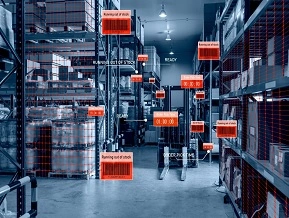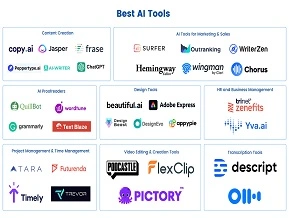Top 10 AI Automation Tools to Supercharge your Workflow in 2025
Why are AI Automation Tools Essential for Modern Workflows in 2025?
The Growing Demand for Speed and Efficiency
In today’s rapidly evolving business landscape, organizations face mounting pressure to deliver results swiftly and efficiently. AI automation tools have become essential in meeting these demands by enabling intelligent decision-making and streamlining workflows. By automating complex processes and analysing large volumes of data quickly, these tools help businesses maintain a competitive edge in a fast-paced environment. The ability to respond promptly to market changes, customer needs, and operational challenges is increasingly crucial, making AI-driven automation a strategic priority across industries.
Reducing Repetitive Tasks to Boost Productivity
A core advantage of AI automation is its capacity to manage repetitive, time-consuming tasks that can drain employee energy and resources. Automating mundane processes such as data entry, report generation, or routine customer inquiries frees up valuable time for teams to focus on higher-value strategic activities. This shift not only enhances productivity but also improves job satisfaction by allowing employees to engage in more meaningful and creative work. As a result, organizations experience increased efficiency and a more motivated workforce.
Supporting both Technical and Non-Technical Teams
Modern AI automation tools are designed with diverse users in mind. They provide intuitive, smart workflows that support both technical experts and non-technical staff. By offering easy-to-use interfaces and intelligent assistance, these tools foster collaboration across departments and reduce reliance on specialized IT resources. This inclusivity empowers broader teams to contribute to automation initiatives, accelerating implementation and enhancing overall workflow efficiency.
Scalability through Cloud Integration and APIs
The integration of AI automation tools with cloud services and APIs enables organizations to scale their automation efforts seamlessly. Cloud platforms offer flexibility, allowing businesses to expand or modify their workflows without significant infrastructure changes. APIs facilitate the connection between different software systems, enabling smooth data flow and interoperability. Together, these capabilities ensure that AI automation solutions can adapt and grow alongside evolving business needs, supporting long-term success.
How Do Automation Tools and AI Work Together to Drive Innovation?
Combining Automation with Predictive Intelligence
AI automation tools are evolving beyond simple task automation by integrating predictive intelligence, which allows businesses to anticipate future outcomes and proactively optimize their processes. This fusion of traditional automation with AI-driven foresight helps organizations not only react to current demands but also prepare for potential challenges and opportunities. By forecasting trends, identifying risks, and suggesting improvements, predictive intelligence enables smarter, more innovative decision-making that drives sustained growth and efficiency.
Machine Learning Powers Smarter Decision-Making
Central to these advancements is machine learning, which empowers automation systems to continuously analyse data, learn from patterns, and refine decisions over time. Unlike static automation workflows, machine learning-powered tools adapt dynamically to new information, improving accuracy and responsiveness. This makes business processes more efficient and resilient, as AI can identify bottlenecks, predict resource needs, and recommend adjustments before problems arise. The result is a more agile and adaptive operational environment that can better meet evolving market demands.
Enhancing Interaction with NLP and Computer Vision
Technologies such as Natural Language Processing (NLP) and computer vision significantly enhance how AI automation tools interact with users and data. NLP enables systems to comprehend and respond to human language, facilitating natural, conversational interactions through chatbots, voice assistants, and automated document processing. Computer vision allows AI to interpret visual data, from recognizing objects in images to analysing video feeds. Together, these technologies enable smarter, more intuitive human-machine interfaces, improving user experience and expanding the range of automation applications.
Self-Learning Workflows for Ongoing Optimization
Modern AI automation platforms incorporate self-learning workflows that automatically adjust based on changes in user behaviour and shifting business conditions. These adaptive systems minimize the need for manual intervention by continuously optimizing processes to maintain peak performance. As a result, organizations benefit from ongoing efficiency improvements and can rapidly respond to new challenges, ensuring their automation efforts remain relevant and effective over time.
What Features Define the Best AI Automation Tools in 2025?
Intelligent Workflow Orchestration with Minimal Coding
Leading AI automation tools empower users to design and manage complex workflows with ease, requiring little to no coding expertise. These platforms often feature intuitive drag-and-drop interfaces, pre-built templates, and guided setup processes that make automation accessible to both technical professionals and non-technical team members. By lowering the barrier to entry, organizations can democratize automation, encouraging collaboration across departments and speeding up implementation. This ease of use ensures that even teams without extensive programming skills can streamline processes and improve efficiency.
Real-Time Analytics and Data-Driven Decision-Making
A critical advantage of advanced automation tools is their ability to deliver continuous, real-time analytics. These insights allow businesses to monitor workflow performance, detect bottlenecks, and identify issues as they arise. By providing actionable data, these platforms support informed decision-making, enabling teams to optimize operations proactively. The combination of automation and real-time analytics helps organizations respond swiftly to changing conditions, enhance productivity, and maintain high standards of quality and service.
Seamless Integration with CRMs, ERPs, and Cloud Platforms
Top-tier AI automation solutions offer seamless integration with key enterprise systems such as Customer Relationship Management (CRM) platforms, Enterprise Resource Planning (ERP) software, and cloud services. This connectivity ensures smooth data flow and collaboration across different departments and functions. By bridging disparate systems, automation tools enable comprehensive process orchestration and provide a unified view of business operations. This integration capability is essential for scaling automation efforts and maximizing return on investment.
AI-Driven Bots for Task Execution and Customer Interaction
AI-powered bots play a vital role in executing repetitive tasks and enhancing customer engagement. These intelligent bots can handle routine processes such as data entry, scheduling, and transaction processing, freeing human workers to focus on more strategic activities. Additionally, chatbots and virtual assistants improve user experience by providing quick, personalized responses to customer inquiries. Together, AI-driven bots boost both operational productivity and customer satisfaction, making them indispensable components of modern automation strategies.
Which are the Top 10 AI Automation Tools You Should Know in 2025?
UiPath: Advanced RPA with AI-Powered Task Automation
UiPath is a leading platform in robotic process automation (RPA) that combines traditional automation with cutting-edge AI capabilities. By integrating AI, UiPath enables businesses to automate repetitive, rule-based tasks while also incorporating intelligent decision-making processes. This allows organizations to streamline operations, reduce errors, and free employees from mundane work. UiPath’s advanced features support complex workflows, including document understanding, natural language processing, and machine learning, making it a preferred choice for enterprises aiming to enhance efficiency through smart automation.
Automation Anywhere: Scalable Automation with Cognitive Bots
Automation Anywhere is recognized for its highly scalable automation platform that leverages cognitive bots capable of performing tasks that require human-like judgment and adaptability. These bots learn from data, making them ideal for automating processes involving unstructured information, decision-making, and exception handling. The platform’s flexibility allows enterprises to deploy automation across various departments, scaling from small teams to entire organizations. Automation Any where’s focus on cognitive automation helps businesses increase productivity while maintaining agility in dynamic environments.
Zapier + OpenAI: No-Code Automation with GPT Integrations
Zapier, a popular no-code automation platform, has integrated OpenAI’s GPT technology to bring AI-driven intelligence into everyday workflows. This powerful combination allows users to create smart, automated processes without needing any coding skills. By leveraging GPT’s natural language understanding and generation capabilities, Zapier enables more intuitive task automation, such as generating emails, summarizing content, or responding to queries automatically. This integration democratizes AI-powered automation, making it accessible to a broad range of users, from small business owners to large teams.
Make (Formerly Integromat): Visual, AI-Enhanced Workflows
Make offers a user-friendly drag-and-drop interface that simplifies designing and automating complex workflows. Enhanced with AI features, Make allows users to quickly build intelligent automations that connect multiple apps and services seamlessly. Its visual approach helps both technical and non-technical users streamline processes, automate routine tasks, and improve operational efficiency. Make’s AI enhancements empower users to create smarter workflows with minimal effort, accelerating productivity across diverse industries.
What are Some Emerging AI Automation Tools Worth Exploring?
Microsoft Power Automate + AI Builder: Enterprise-Grade AI Integration
Microsoft Power Automate combined with AI Builder delivers a robust enterprise-grade solution that integrates AI seamlessly into automation workflows. This powerful combination enables businesses to automate routine, repetitive tasks while harnessing AI models for advanced data analysis and predictive insights. Users can easily create intelligent workflows that analyse patterns, forecast trends, and make data-driven decisions without requiring extensive technical knowledge. This integration enhances operational efficiency across various departments, helping organizations scale automation efforts with confidence and precision.
Nintex: Workflow Automation with Machine Learning Support
Nintex stands out by incorporating machine learning algorithms into its workflow automation platform. This capability allows workflows to evolve and optimize continuously based on data inputs and outcomes, reducing the need for constant manual intervention. By adapting to changing business conditions and improving over time, Nintex helps organizations increase productivity and reduce errors. The platform’s intuitive design also makes it accessible to users across different levels of technical expertise, driving widespread adoption.
WorkFusion: Intelligent Automation for Document-Heavy Tasks
WorkFusion specializes in automating document-intensive processes, leveraging AI-powered bots to handle unstructured data such as invoices, contracts, and forms. Its advanced capabilities in data extraction, classification, and validation streamline tedious manual tasks, freeing up valuable human resources. By automating complex document workflows, WorkFusion helps organizations reduce processing time, minimize errors, and improve compliance, making it ideal for industries like finance, healthcare, and legal services.
Tines: AI-Powered Automation for Security and IT Operations
Tines focused on automating security and IT operations workflows with AI-driven automation. By accelerating response times and reducing human error, Tines enhances the effectiveness of cybersecurity teams. Its platform enables organizations to automatically detect, investigate, and remediate security incidents, ensuring faster and more accurate threat management. This targeted automation improves operational resilience and helps businesses safeguard their critical infrastructure.
How Do These AI Automation Tools Compare Across Use Cases?
Level of AI Integration: Basic vs. Full Cognitive Automation
AI automation tools vary widely in their sophistication and capabilities. On one end of the spectrum is basic automation tools designed to handle simple, repetitive tasks with predefined rules. These tools are excellent for automating straightforward workflows but lack the ability to adapt or learn from new data. On the other end, full cognitive automation platforms leverage advanced AI techniques such as machine learning, natural language processing, and computer vision. These systems can understand, interpret, and independently adjust to complex workflows and changing business environments, making them highly adaptable and intelligent. Choosing the right level of AI integration depends on the complexity of your processes and the desired outcomes.
Suitability across Business Areas
Different AI automation tools are optimized for various business functions. Some focus on automating core business processes like finance and HR, while others specialize in IT operations, marketing automation, or customer service workflows. Selecting a tool that aligns closely with your organization’s primary needs ensures better adoption and more impactful results. For example, customer service teams benefit from AI-powered chatbots and sentiment analysis, while IT teams may require automated incident management and security operations.
Usability: Low-Code/No-Code vs. Developer-Heavy Platforms
Usability is a critical factor when evaluating automation platforms. Low-code and no-code tools empower non-technical users to design and deploy workflows through intuitive interfaces, reducing reliance on IT departments. These platforms accelerate implementation and foster collaboration across teams. In contrast, developer-heavy platforms offer extensive customization and flexibility, suitable for organizations with complex requirements and in-house development expertise. The choice depends on your team’s skill set and the level of control you need.
Cost, Scalability, and Integration Flexibility
Cost structures, scalability, and integration capabilities play vital roles in long-term success. Some platforms offer subscription-based pricing ideal for small to medium businesses, while enterprise solutions provide scalable options to support growing operations. Equally important is seamless integration with existing systems such as CRMs, ERPs, and cloud platforms. Flexible integration ensures smooth data flow, reduces silos, and maximizes the return on automation investments.
How Can You Choose the Right Automation Tools and AI Stack?
Define Your Business Objectives and Automation Maturity
Start by understanding your organization’s goals and current automation capabilities to select tools that fit both immediate and future needs.
Evaluate Integration Needs with Existing Tools
Consider how well the automation tools integrate with your current software like Slack, Salesforce, and other platforms to ensure smooth workflows.
Consider Ease of Use, Learning Curve, and Vendor Support
Choose tools that match your team’s technical skill level and provide robust vendor support and learning resources for faster adoption.
Align Tools with Your Team’s Expertise and Scaling Plans
Select scalable solutions that suit your team’s technical expertise and can grow with your organization as automation expands.
Conclusion
The future of AI automation tools points toward autonomous agents capable of executing complex, multi-step tasks without human intervention. These tools will feature deep integration with large language models (LLMs), enabling dynamic decision-making and adaptive workflows. Alongside these advances, there will be an increased focus on governance, ethics, and responsible AI use to ensure fairness and transparency. Additionally, AI copilots will expand across business platforms, assisting users in real time and enhancing productivity through intelligent, context-aware support.











